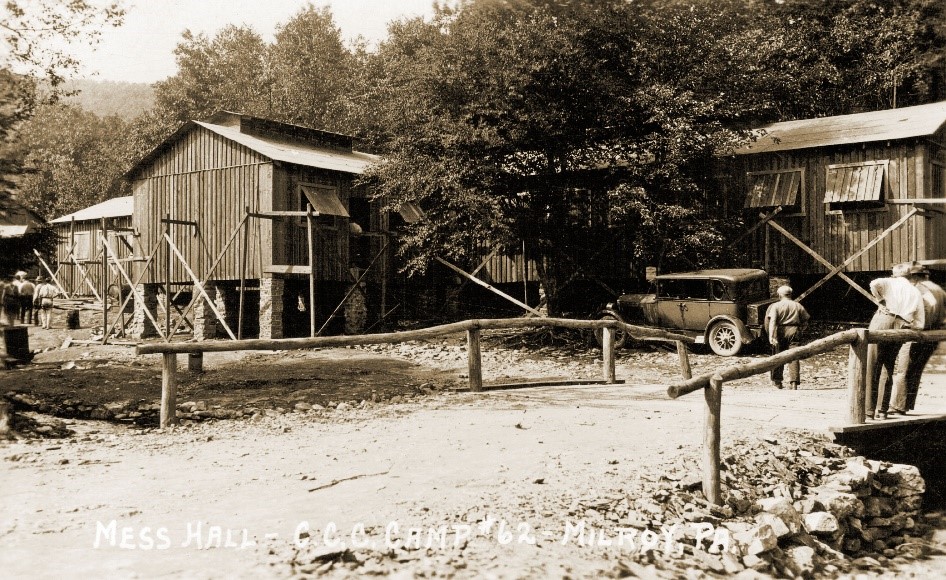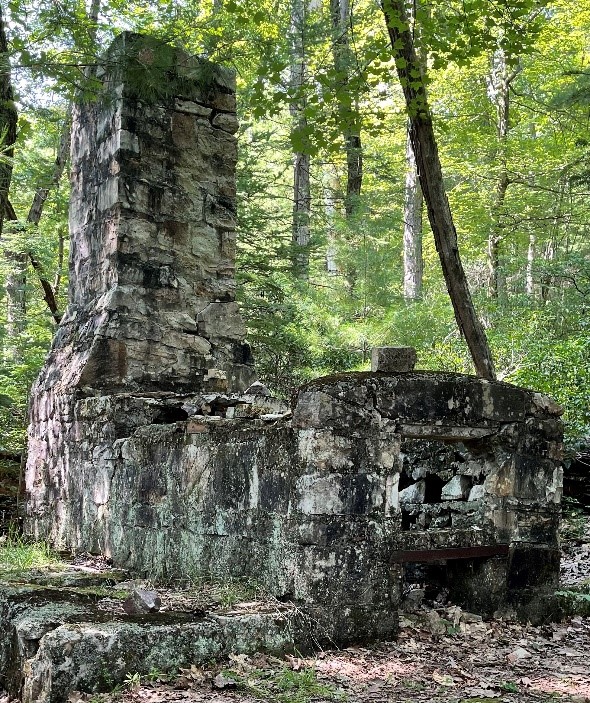As previous articles on Camp S-62 suggest, both sports teams and musical groups played a significant role in influencing camp life for Company 361-C. A final component of this dynamic that should be noted are the various educational opportunities that the men had during their enrollment period at Camp S-62. Across the country, similar opportunities were being made available to men in the Civilian Conservation Corps as part of a formal education program that was organized in late 1933.[1] The creation of such a program within the C.C.C. not only provided men with employment, but also education, which many may not have been able to receive in the past. As a result, the men of Company 361-C were able to gain valuable knowledge and skills that they were able to utilize once their enrollment period at Camp S-62 came to an end.

Pictured above is an official company portrait, taken between 1933-35 by D. J. MacDonald. Camp Commander, Captain Arthur T. Eaker can be seen seated in the middle. (Courtesy of the Pennsylvania CCC Online Archive)
Camp S-62 was swift to develop its own educational program which formed in late January 1934. Under the guidance of 2nd Lt. Harry E. Eyler, the camp’s first Educational Officer, various subjects were available to the men including auto mechanics, mathematics, cooking, dancing, instrumental music, and elementary reading. Additionally, several men helped to promote this program by becoming qualified instructors to teach these subjects to others in Company 361-C.[2] A surveying corps was also established at Camp S-62 to teach the men how to locate county lines and lay fire trails. This work proved vital when a large forest fire swept through the Seven Mountains region in May 1934 shortly after the surveying corps was formed. This surveying corps consisted of five men, from a surveying class of 12 enrollees. The class was instructed by David Arnold of Milroy; presumably a locally employed man (LEM) hired by the Park Service to offer his expertise to the men of Company 361-C. At these classes, held every Monday night, the men received “a wonderful knowledge of surveying.”[3]

Pictured above is the mess hall that was located at Camp S 62. (Courtesy of the Pennsylvania CCC Online Archive)
In the spring of 1934, officials from the C.C.C.’s educational program made the progressive move to place African Americans in supervisory positions such as educational advisors within black camps.[4] Consequently in May of 1934, Clarence J. Grinnell was assigned to the role of Educational Advisor at Camp S-62. Originally, Mr. Grinnell had been placed at Camp 317 in Hills Grove, Pa. However, this had been a mistake made by officials at the Third Corps Headquarters. He was retracted from Camp 317 due to it being a white camp.[5] This provides some insight into the societal contentions of the era in which African Americans were prohibited from overseeing white enrollees.
Under a new program outlined by Dr. Thomas G. Bennett, the Third Corps Area Educational Adviser, and the leadership of Mr. Grinnell, the education program was transformed at Camp S-62. As of July 26, 1934, the educational courses that were offered at the camp included subjects like physiology, hygiene, elementary and advanced English, high school mathematics, radio, care and operation of motor vehicles, penmanship, cooking, choral singing, geography, forestry, civics, poultry husbandry, public speaking, surveying, road construction and nine other unnamed subjects that were available if there was any interest among the men. This vast array of educational opportunities caught the eye of nearly thirty-two percent of the company’s men.[6] This education program proved to be a vital asset for Company 361-C. Accordingly, the utility of the education at this camp must also be admired for if an enrollee “desired instruction in most any subject” they were “quickly accommodated.”[7] Along with these courses, the men were also shown lectures on various educational topics such as “swimming and resuscitation,” forestry, first aid, citizenship, and safety.[8]

Pictured above are remnants of the bake oven which was located behind the dining hall in Penn Roosevelt State Park. (Photo taken by the author.)
In addition to these established education programs, some men were able to gain experience by writing newspaper articles about happenings at the camp. It was from these articles that the bulk of this research on Camp S-62 derives. From the fall of 1933 until the company transferred two years later, the camp had five different authors who were members of Company 361-C. The authors reporting on the company were Arthur “Spike” Spady, Cheyney H. Thomas, William H. Bryant, “Yub” Carter and George “Buddy” Burrell. The latter two were co-authors and united under the pen name Bud ‘N Yub. The varying authorship can duly be noted by the substances of the articles themselves. While some writers placed emphasis on the different social aspects of the camp, others did not elaborate as much. This in affect blurs what one can learn about the different aspects of Camp S-62 over time.
Throughout February, I have authored a number of articles about Company 361-C. It was my hope that, through these efforts, I was able to tell the forgotten story of the men from this company by looking into the athletic, musical, and educational components of camp life. Evidence of the work that these men did can still be observed today in and around Penn Roosevelt State Park. I would like to thank Shippensburg University for giving me the opportunity to conduct this research and the Pennsylvania Parks and Forests Foundation for allowing me to publish my findings.
This article was written by Jacob Hockenberry based off information compiled through a summer research opportunity. Jacob is a senior at Shippensburg University where he is studying history, political science, and geographic information systems (GIS). He intends on furthering his education by pursuing a master’s degree in historic preservation.
The Civilian Conservation Corps Camp S-62 article series can be found on the News page of our website, or via the direct links below:
“Ramblings” at Penn-Roosevelt: A Look at African American CCC Camp S-62
The “Maroon Devils” of Company 361-C: Sports at Camp S-62
Penn-Roosevelt Quintet: Music and Entertainment at Camp S-62
To receive notifications about upcoming blog posts, updates on Pennsylvania’s state parks and forests, and events and happenings with PPFF Friends Chapters around the state, sign up to receive our weekly Take Five e-blast.
Resources:
[1] John C. Paige, The Civilian Conservation Corps and the National Park Service, 1933-1942: An Administrative History (National Park Service: U.S. Dept. of the Interior, 1985), 83-85.
[2] “Milroy Camp,” Philadelphia Tribune, February 1, 1934.
[3] William H. Bryant, “Camp Milroy,” Philadelphia Tribune, May 24, 1934; Cheyney Thomas, “Camp Milroy,” Philadelphia Tribune, March 29, 1934.
[4] Calvin W. Gower, “The Struggle of Blacks for Leadership Positions in the Civilian Conservation Corps: 1933-1942,” The Journal of Negro History 61, no. 2 (April 1976): 128.
[5] William H. Bryant, “Camp Milroy,” Philadelphia Tribune, May, 10, 1934.
[6] “Camp S-62, Pa.,” Philadelphia Tribune, July 26, 1934.
[7] “361st Co. C.C.C., Milroy, Pa.,” Philadelphia Tribune, November 1, 1934.
[8] “Camp S-62, Pa.,” Philadelphia Tribune, July 26, 1934; C. J. Grinnell, “Big Program In Camp For New Recruits,” Philadelphia Tribune, August 9, 1934; Bud ‘N Yub, “Camp S.62 CCC Milroy, Pa.,” Philadelphia Tribune, January 17, 1935.




